This High-Flying Former UT Cheerleader Is Giving Back - The Alcalde
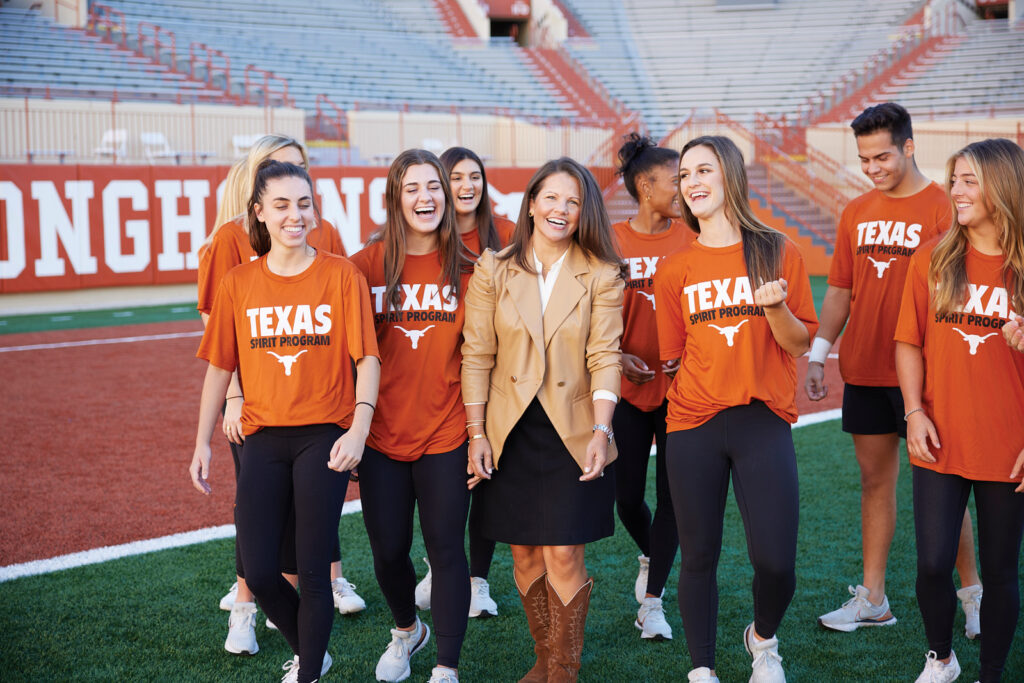
On a warm September day in 2016, Amy Porter put on her Texas cheerleading uniform and headed toward Darrell K Royal-Texas Memorial Stadium to cheer on The University of Texas Longhorns against the UTEP Miners. As she walked onto the field alongside her former squad mates, cameras quickly panned around and trained their lenses on Porter and crew. What photographers caught was Porter surprising her daughter, Morgan Baker, then a sophomore, who was already cheering on the sidelines. After a quick hug—and a look of utter disbelief from Baker—Porter picked up a pair of poms and joined her to become the first mother-daughter duo to cheer together at a UT game.
It had been more than 20 years since Porter last donned the iconic fringe, and in that time the former Texas Cheer & Pom athlete had built a family and launched a multimillion-dollar financial tech firm called Affinipay in 2005, which helps law firms accept direct-from-consumer credit card payments for legal services. The Austin-based company is used in more than 60,000 U.S. law firms and processed a record-breaking $18 billion in payment volume in 2022, according to Porter.
Her success in tech, the entrepreneur says, is as much to do with the skills she learned as a member of Cheer & Pom as she did in the College of Natural Sciences, where she graduated with a degree in merchandising in 1995. Those skills also inspired Porter to help launch a Texas Exes Cheer & Pom Alumni Network and create an endowment to help 10 Cheer & Pom captains and leaders with scholarships. It's the first-ever gift of its size designated for the sport.
"The real unique and special thing about the Cheer & Pom Alumni Network is Amy Porter's support. Not all of our networks or chapters have so much financial backing," says Catherine Flores, Chapters and Networks Manager for Texas Exes.
Flores notes that Cheer & Pom already had a strong, organized alumni community—perhaps unsurprising considering they're cheerleaders—but Porter's gift helped make it official. It also issued a rallying cry for her fellow alumni to cement the Cheer & Pom legacy for future generations.
"The network is not just engaging socially, but also in giving back," Flores says. "They want to be able to support equipment needs, and create a space where the team can have consistent practices."
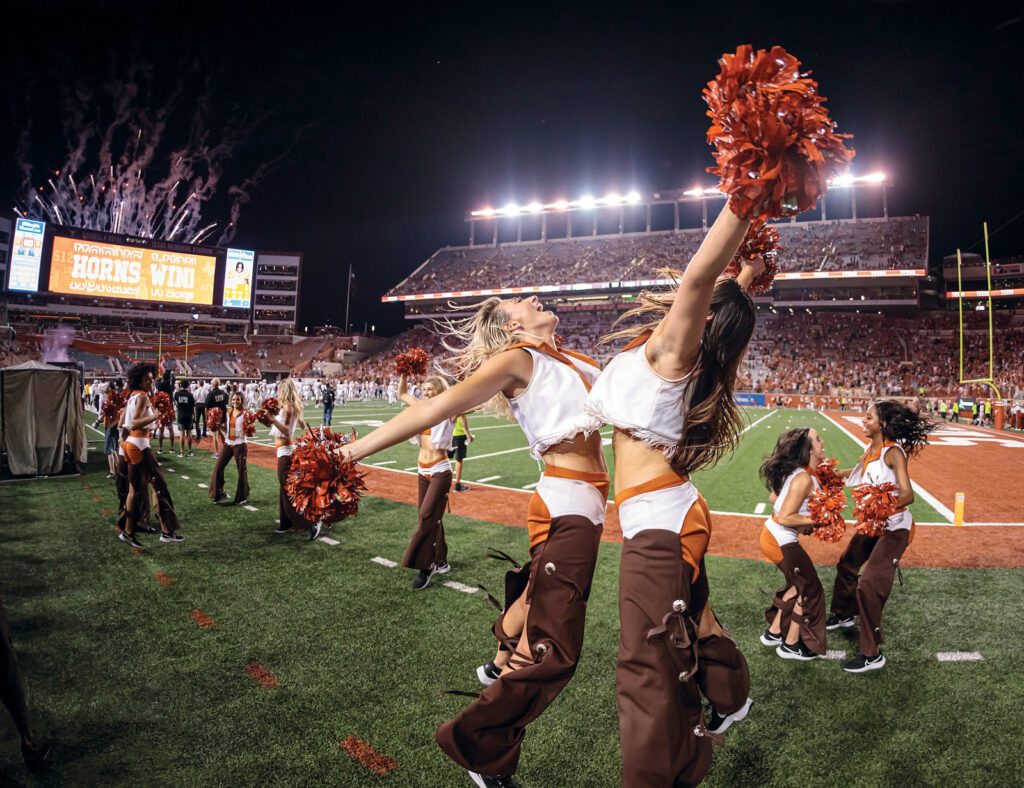
Porter first fell in love with cheerleading in middle school when the self-described "kamikaze" of a kid started doing back handsprings in seventh grade. She grew up in a military family and spent most of her childhood moving around the Southern U.S. before landing in San Antonio for high school. ("When you're in the military," Porter jokes, "all roads kind of naturally lead back to San Antonio.")
After receiving her acceptance letter to UT—a good thing, since it was the only school she had applied to—she landed on the cheer team, a decision that shaped the rest of her life. Like most sports, cheer required a hefty time commitment from Porter, who commuted to campus for 6 a.m. practices from a small apartment on Riverside Drive where she paid $150 per month rent to bunk with two roommates she knew from San Antonio.
"I didn't know West Campus—I didn't know it was a thing," she says. "And I couldn't afford to live in dorms."
Porter paid her way through college using student loans and often working three jobs at a time to make ends meet. Despite her workload both in the classroom and out, Porter remained committed to her sport, finding not just purpose, but community.
"For me, it was really about what would happen during the week, not just on gamedays. The 6 a.m. practices, the late nights, all the stuff in the middle is what really defined my college experience," Porter says. "Two of my closest friends now are girls that I cheered with … [Cheer] very much changes the trajectory of your life. Who are those people you meet? [What] are those experiences?"
Cheer also changed the direction of her professional career. Porter spent her early 20s selling uniforms for Varsity, a company that makes cheerleading and band uniforms. As she traveled across South Texas visiting different clients, Porter would haul fax and credit card machines to help make the transactions. Her experience helped Porter zero in on a unique hole in the consumer payment market, which planted the seed to eventually launch Affinipay in 2005. Its Westlake headquarters, which shares a campus with Samsung and Spiceworks among other big-name companies, boasts burnt-orange accent walls, UT-themed meeting rooms, and pep rally-esque all-hands meetings Porter holds for her 500 or so employees.
Building a multimillion-dollar business as a single mom raising two kids may seem like a monumental task, but Porter says the time management and fierce dedication were things already instilled in her from her UT days.
"People don't realize it just takes up so much time, so much commitment," she says of being a Cheer & Pom athlete. "You live it, breathe it. When you're in the program, it becomes your priority." Later adding, "Most kids that come through the program, they have a very similar experience."
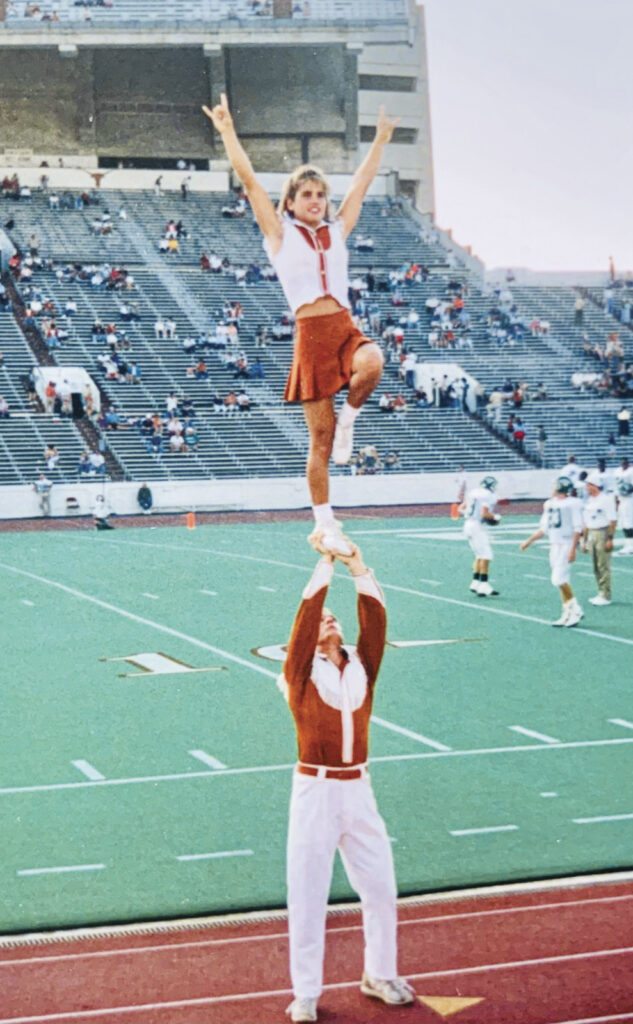
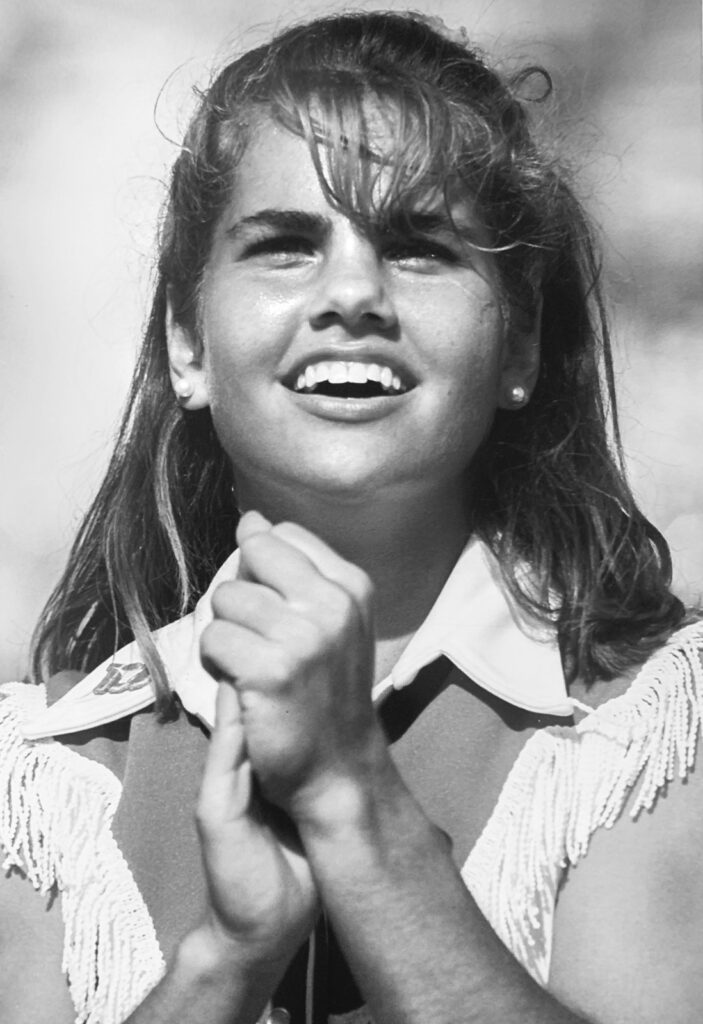
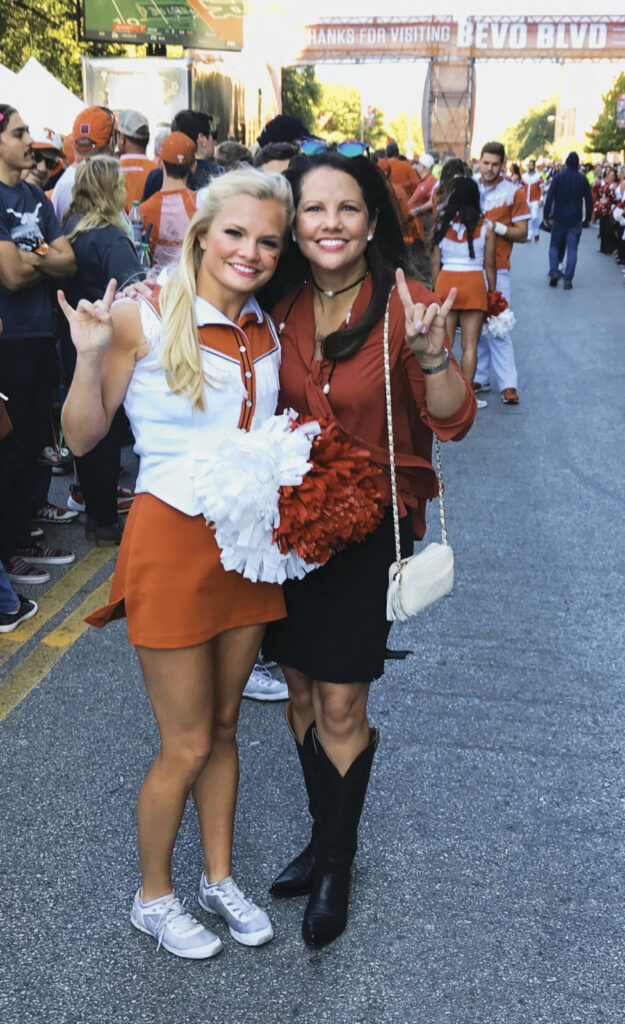
Porter got a firsthand look at what today's young athletes experience while her daughter was a part of UT's Cheer & Pom team from 2015–19. Inspired by her mother, Baker began cheering in elementary school and had her sights set on The University of Texas at an early age.
"I joke that in elementary school, I thought [UT] was part of the school district," Baker says. "We grew up going to every home game—it was a huge part of our life."
Twenty years after her mom put on the burnt-orange skirt, Baker found herself a second-
generation member of Texas Cheer & Pom. The thing that had so shaped her mother's college years would now shape her experience, too.
"[My mom] really does think that—and I believe this too—[that] the Texas Cheer program is super unique in that we really are ambassadors for the university," says Baker, who is now a realtor with Austin-based Gottesman Residential Real Estate, owned by Laura Gottesman, BS '85, Life Member. "Learning how to network, hold yourself to a different standard, it really does teach you that."
Baker says that while much of what the program is known for—leadership opportunities, business development experience—has remained the same, the Spirit Squad, comprised of Texas Cheer & Pom and UT's Hook 'Em mascot program, has grown remarkably over the last two decades. Yes, cheerleading in the mid-1990s featured pyramids and flips, but the culture shifted in the early aughts to include the high-flying mix of gymnastics and gravity-defying stunts it is today. Pom athletes saw a similar pivot as they went from rah-rah rally girls to professionally trained dancers and entertainers. Even Hook 'Em's responsibilities have grown. Demands on the mascot have increased right along with the rest of the squad, making multiple students responsible for his appearances. (A note: Some people, including Assistant Coach Andy Pendelton, remained mum when pressed for a number of Hook 'Ems that exist. Less secretive sources revealed there are five.)
The responsibilities of the program have grown to include 102 members responsible for making more than 200 appearances per year, yet the squad is still largely responsible for funding their own uniforms, flights, gear, and finding space for their four-times-a-week practices (they're also required to do at least two weightlifting sessions per week, Head Coach Blair Brown notes). Before Porter got involved, team captains would often be left scrambling to find a space for the squad, which is split between the all-girls cheer squad, the co-ed squad, and the Poms. Sometimes, Cheer & Pom would be left practicing outdoors while the teams they cheer for did drills in climate-controlled gyms.
Working with Texas Athletics, Porter has worked hard to make sure the team has consistent practice space at a flex gym inside DKR, creating the kind of consistency athletes crave and allowing them to focus on things outside of cheer, like their studies. As UT's reputation as an elite university has grown, so too have the academic demands on the student-athletes.
"It used to be top 10 percent automatic admission from high school and now it's top 6 percent. They are really bright, driven, intelligent students," Brown says. "They're all really passionate about what they're doing here, and then they're all really athletic."
One only needs to stop by a 7 a.m. Monday practice, an hour when it's impossible to believe anyone can tie their shoes let alone throw themselves 20 feet in the air, to see that athleticism on display. As the all-girl White Squad practices stunting in one corner, and the co-ed Orange Squad perfects the boy-girl pyramid, a feat that looks terrifying but ultimately reinforces the belief that if we catch our friends before they fall (literally), then maybe things will be okay. Most of the young women on the squad cheered, did gymnastics, or danced for years before heading to UT. Few of the young men, however, have experience in cheer. Instead, the team tends to spot buff students around campus and then invite them to try out for the team. (Brown says it can take some convincing to get them to show up to a practice, but once they do, they almost always stick around. "They realize the athleticism it takes and that it's harder than they thought it was going to be, and then they get addicted," she says.)
But the practice isn't perfect. It is filled with sweat, tears, and concussion protocols after one girl acting as a base gets kicked in the head by a flyer during a pyramid routine. After 15 minutes of questions, the athletic trainer is assured the base is okay and lets her back onto the mat.
Despite the athletes' weekly commitment to 10-plus hours of practice, gym sessions, and their presence at football, basketball, and volleyball games, Cheer & Pom is designated a club. Unlike many schools, including the University of Alabama, University of Tennessee, and Texas Tech, Cheer & Pom doesn't fall under Texas Athletics and is therefore not technically considered a sport. Though the team gets some advantages, such as access to the athletic dining room and priority registration, a perk that helps the students create a schedule that fits around practice and games. Before, Cheer & Pom had to register for classes along with non-athletes, making it difficult to create a schedule that fit around practice and games.
"With our schedule, if you have a class during practice, you miss everything. And class comes first, you come here to go to school. But we can't just throw you in on gameday—it's dangerous," Brown says. "You wouldn't put a football player on the field with no practice."
Texas Cheer & Pom may never get their own dedicated ESPN GameDay (though they are featured a lot when the TV show comes to Austin), it's the small changes that make a big impact: dedicated practice space, consistency, early registration, and the financial freedom that Porter didn't have as she worked three jobs to get through school. Earlier this year, the Texas Exes hosted the Scholarships Dinner, a banquet where the recipients of Porter's endowment got to spend the evening with her and Brown. Watching the evening unfold, Brown says she found herself holding back tears as she grasped the magnitude of the gift.
"Amy's impact on the program—there's so much to be done and to do and her willingness to spearhead it … I just want to make sure people understand the effort she's putting in on campus along with everything else she's doing, [like] running a company," Brown says. "That's the kind of people this program produces."
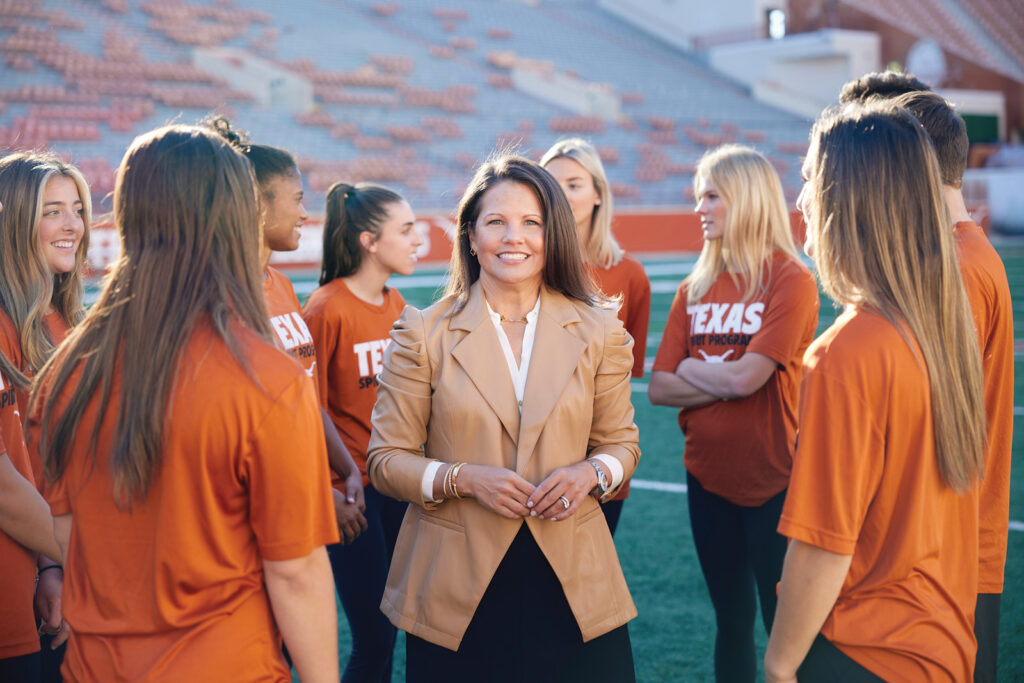
Though decidedly more demure when asked about her impact on the program, Porter agrees with the caliber of alumni created by Texas Cheer & Pom and wants to ensure it continues. "My life was cheering at Texas. And I know that sounds crazy, but that gave me this belief like I can do anything [and] the competence to do that and never look back. The kids coming through the program now, I want them to feel that," she says.
Back before she launched Affinipay, Porter was a single mom raising two children, carting credit card and fax machines to sales meetings when she saw an opportunity. She didn't have an MBA, but she says she did have an inclination that her business idea would work. And it did. Twenty years later, she sees a new opportunity to help bring Cheer & Pom into the next generation by launching a new group of leaders and ensuring the sport gets respect. And chances are she will be successful. After all, if anyone can do it, it's the same kamikaze seventh grader who performed back handsprings on a dare and kept on flipping.
CREDITS: Buff Strickland; Courtesy Amy Porter, Texas Athletics
Comments
Post a Comment